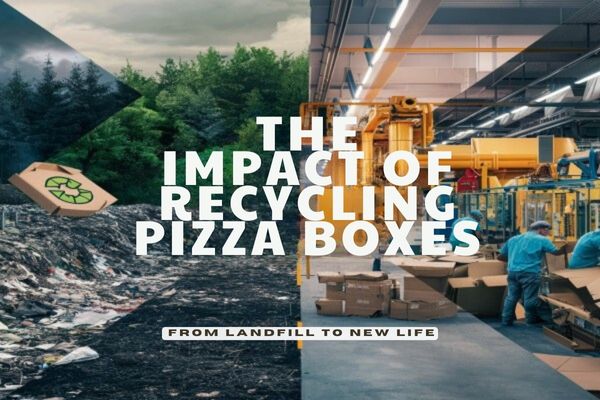

We’ve all enjoyed a delicious pizza and then wondered, can we toss the box into the recycling bin? The answer isn’t as straightforward as we’d hope. While pizza boxes are made of recyclable cardboard, the presence of grease and food residue can complicate things. If we’re to do our part in reducing landfill waste, we should understand the right steps to recycle them properly.
So, how do we handle those greasy sections, and what guidelines should we follow? Let’s explore the dos and don’ts of recycling pizza boxes.
Yes, we can recycle pizza boxes, and it’s important to know the facts. In the U.S., about 3 billion pizza boxes are used each year, making a substantial contribution to cardboard waste. Recycling these boxes keeps tons of material out of landfills and supports environmental health.
Pizza boxes are indeed recyclable, despite common misconceptions. Many people think that because pizza boxes often have grease and food residue, they can’t be recycled. However, most recycling centers are equipped to handle a normal amount of food contamination. We just need to make sure that large chunks of leftover pizza are removed before tossing the box in the recycling bin.
The key issue is the cardboard material itself. Pizza boxes are made from corrugated cardboard, which is highly recyclable. When we recycle these boxes, the cardboard is broken down into fibers, which can then be used to make new products. This process helps save trees and reduces the amount of waste going to landfills.
However, if a pizza box is excessively greasy or has too much cheese stuck to it, it’s best to tear off the soiled parts and recycle the clean sections. This simple step can make a big difference.
Many of us are aware that pizza boxes are recyclable, but it’s surprising how few people actually know the statistics behind pizza box recycling in the U.S. For starters, only 57% of Americans realize that pizza boxes can be recycled in the first place. This is quite low, considering that most people have access to pizza box recycling services.
A recent survey by DS Smith found that 40% of consumers do not recycle pizza boxes, highlighting a gap in awareness. This survey emphasizes the need for increased awareness about pizza box recycling.

In the U.S., we use about 3 billion pizza boxes each year. This amounts to roughly 600,000 tons of cardboard material that can be recycled instead of ending up in landfills. Notably, 10 states and the District of Columbia have over 90% of residents who can recycle their pizza boxes. This shows that the infrastructure is there, but awareness is lacking.
Additionally, 73% of U.S. recycling centers are equipped to handle the normal amount of food residue found on pizza boxes. This means that in most places, you don’t need to worry too much about leftover cheese or sauce. This study debunked the myth that food residue makes pizza boxes unrecyclable. This means that in most places, you don’t need to worry too much about leftover cheese or sauce.
Pizza boxes can account for up to 2.6% of all cardboard recycling, highlighting their significance in the recycling stream. These statistics show that there’s a lot of potential to improve our pizza box recycling habits.
Also Reas: Book Recycling Magic: 6 Ways to Upcycle Your Tomes
Let’s start by making sure we’re recycling our pizza boxes correctly. First, we need to remove any leftover food and greasy liners, as these can contaminate the recycling process. Next, flatten the boxes to guarantee space in the recycling bin and ensure they’re accepted by the recycling center.

To guarantee our pizza boxes are properly recycled, we need to follow a few straightforward steps.
First, we should remove any leftover food. Pizza crusts, cheese, and toppings can contaminate the recycling process, so it’s crucial to clear out all remnants.
Next, we need to check the box for grease stains. While a bit of grease is usually acceptable, large grease spots can be a problem. If the bottom of the box is too greasy, we should tear it off and discard that section.
Once the box is clean and free from significant grease, we can flatten it. Flattening the box makes it easier to handle and ensures it takes up less space in the recycling bin.
When recycling pizza boxes, we should check with our local recycling centers to understand their specific guidelines and requirements. Each center might have different rules about what they can accept, and knowing these can help guarantee our efforts are effective.
Here are some tips to make sure our pizza boxes are accepted:
Also Read: Food Waste Reduction: Simple Tips for Major Impact
Recycling pizza boxes has significant environmental benefits, as it helps reduce the amount of cardboard waste in landfills. By recycling these boxes, we contribute to a more sustainable paper industry that can repurpose the material for new uses. With millions of pizza boxes used each year, this small action can make a big difference in cutting down waste and promoting a circular economy.

By recycling pizza boxes, we’re greatly reducing the amount of cardboard waste that ends up in landfills. Recycling cardboard materials, like pizza boxes, has numerous environmental benefits that we can’t ignore. When we recycle, we conserve natural resources, save energy, and reduce pollution.
Recycling pizza boxes might seem like a small act, but when we all participate, the impact is significant. By doing our part, we help create a cleaner, healthier planet. Let’s make sure we recycle our pizza boxes and contribute to these essential environmental benefits.
Every pizza box we recycle keeps valuable cardboard out of our already overflowing landfills. With about 3 billion pizza boxes used each year in the U.S., that’s 600,000 tons of material we can keep from piling up in landfills. This not only saves space but also reduces the amount of waste that needs to be managed and processed.
Most of us mightn’t realize it, but 73% of U.S. recycling centers are equipped to handle pizza boxes, even with some food residue. That means the majority of us have the opportunity to recycle our pizza boxes instead of tossing them in the trash. When we make this small effort, we contribute to a significant reduction in landfill waste.
In fact, pizza boxes can make up to 2.6% of all cardboard recycling. By recycling these boxes, we’re not just helping the environment; we’re also supporting a more efficient waste management system. This simple action can lead to a big impact.
When more people become aware that pizza boxes can be recycled, we can collectively make a difference in reducing the amount of waste that ends up in landfills.
Also Read: Reduce Thanksgiving Food Waste with These Genius Tricks!
Recycled pizza boxes can be transformed into a variety of paper products, showcasing their potential in the paper industry. When we recycle these boxes, they get broken down into pulp, which can be used to create new paper items. This process helps save trees and reduces waste, making it an important step toward a more sustainable future.
Here are three ways recycled pizza boxes can be utilized:
Old pizza boxes can be recycled, but only if they’re not too greasy. Remove any leftover food and tear off any heavily soiled sections. If the box is clean enough, flatten it and put it in your recycling bin.
Domino’s encourages recycling pizza boxes as part of their commitment to environmental responsibility. They understand that recycling reduces waste, conserves resources, and helps protect the planet.
Frozen pizza boxes are generally recyclable, but it’s always best to check with your local recycling center. They may have specific guidelines regarding the amount of grease and food residue they accept.
We can recycle pizza boxes if we follow the right steps. By removing food scraps and greasy liners, flattening the boxes, and tearing off heavily stained sections, we can make sure they’re ready for recycling.
Remember to check your local recycling guidelines. Recycling pizza boxes helps reduce landfill waste and pollution, making a positive impact on the environment. Let’s all do our part to recycle properly and keep our planet clean.

Don't let aphids, slugs, and caterpillars ruin another plant. Take back control with simple, natural methods that actually work.